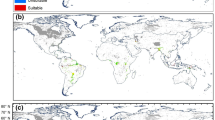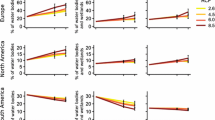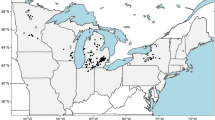Abstract
Twenty-four aquatic neophytes have been introduced to Germany so far and at least 16 non-native species established stable populations in northern and north-western Germany. Invasive aquatic neophytes can cause serious ecological and economic problems in lakes and other freshwater ecosystems. In the presented study, a species distribution model was used to identify possible habitats for neophytes in Bavaria (Southern Germany) and to predict which Bavarian lakes might become suitable habitats for neophytes due to climate change. A total of 55 Bavarian lakes were fitted with high-resolution temperature loggers as part of this monitoring programme. Furthermore, the physical and chemical properties of the lakes were determined and verified in regular intervals. The presence or absence of the native thermophilic macrophyte Najas marina L. was used as an indicator to determine whether a lake was a suitable habitat for neophytes. The results revealed that the spread of neophytes in Bavaria is mainly limited by spring and summer water temperature. In contrast, nutrient concentrations in the water showed no significant influence. Suitable lakes reached temperatures of at least 15 °C for 2 months during spring and at least 20 °C for 2 months during summer. By comparison, the water temperatures in lakes classified as not suitable for neophytes were 2–5 °C lower. The computed predictions for the estimated temperature increase of 1.4 °C, for the period between 2021 and 2050, indicate that up to 70 % of Bavarian lakes might become suitable habitats for neophytes.



Similar content being viewed by others
References
Agami M, Waisel Y (1983) The effect of temperature and photoperiod on growth of Najas marina L. In: Proceedings, international symposium on aquatic macrophytes, pp 18–23
Agami M, Waisel Y (1984) Germination of Najas marina L. Aquat Bot 19:37–44
Angelstein S, Schubert H (2009) Light acclimatisation of Elodea nuttallii grown under ambient DIC conditions. Plant Ecol 202:91–101
Barko JW, Hardin DG, Matthews MS (1982) Growth and morphology of submersed freshwater macrophytes in relation to light and temperature. Can J Bot 60:877–887
Bräuchler C (2015) Towards a better understanding of the Najas marina complex: notes on the correct application and typification of the names N. intermedia, N. major, and N. marina. Taxon 64:1028–1030
Casper SJ (1979) Beitraege zur Taxonomie und Chorologie europaeischer Wasser- und Sumpfpflanzen 2. Was ist Najas marina L.? Feddes Repertorium 90:217–238 (Report in German)
Casper SJ, Krausch HD (1980) Pteridophyta und Anthophyta (Book in German). Spektrum Verlag, Stuttgart
Doll R, Pankow H (1989) Die Verbreitung der Sippen der Gattung Najas L.in den Nordbezirken der DDR. Feddes Repertorium 100:431–438 (Report in German)
Dormann CF, Blaschke T, Lausch A, Schröder B, Söndgerath D (2004) Habitat-modelle – Methodik, Anwendung, Nutzen. Tagungsband zum Workshop vom 8.-10. Oktober 2003 am UFZ Leipzig. UFZ-Berichte 9. UFZ-Umweltforschungszentrum Leipzig-Halle GmbH (Book in German)
Geist J (2014) Trends and directions in water quality and habitat management in the context of the European Water Framework Directive. Fisheries 39:219–220
Handley RJ, Davy AJ (2005) Temperature effects on seed maturity and dormancy cycles in an aquatic annual, Najas marina, at the edge of its range. J Ecol 93:1185–1193
Hanley JA, McNeil BJ (1982) The meaning and use of the area under a receiver operating characteristic (ROC) curve. Radiology 143:29–36
Hoffmann M, Sacher M, Lehner S, Raeder U, Melzer A (2013a) Influence of sediment on the growth of the invasive macrophyte Najas marina ssp intermedia in lakes. Limnologica 43:265–271
Hoffmann M, Gonzales AB, Raeder U, Melzer A (2013b) Experimental weed control of Najas marina ssp. intermedia and Elodea nuttallii in lakes using biodegradable jute matting. J Limnol 72:485–493
Hoffmann M, Raeder U, Melzer A (2014a) Influence of the gender on growth and phenology of the dioecious macrophyte Najas marina ssp. intermedia. Hydrobiologia 727:167–176
Hoffmann M, Raeder U, Melzer A (2014b) Influence of environmental conditions on the regenerative capacity and the survivability of Elodea nuttallii fragments. J Limnol 74:12–20
Hosmer DW, Lemeshow S (2000) Applied Logistic Regression. 2nd edn. Wiley, New York
Hussner A (2009) Growth and photosynthesis of four invasive aquatic plant species in Europe. Weed Res 49:506–515
Hussner A (2012) Alien aquatic plant species in European countries. Weed Res 52:297–306
Hussner A, Losch R (2005) Alien aquatic plants in a thermally abnormal river and their assembly to neophyte-dominated macrophyte stands (River Erft, Northrhine-Westphalia). Limnologica 35:18–30
Hussner A, Van de Weyer K, Gross EM, Hilt S (2010) Comments on increasing number and abundance of non-indigenous aquatic macrophyte species in Germany. Weed Res 50:519–526
Jacobs MJ, Macisaac HJ (2009) Modelling spread of the invasive macrophyte Cabomba caroliniana. Freshw Biol 54:296–305
Keller RP, Geist J, Jeschke JM, Kuehn I (2011) Invasive species in Europe: ecology, status and policy. Environ Sci Eur 23:1–17
Kunii H (1982) The critical water temperature for the active growth of elodea-nuttallii. Jpn J Ecol 32(1):111–112
McKee D, Hatton K, Eaton JW, Atkinson D, Atherton A, Harvey I, Moss B (2002) Effects of simulated climate warming on macrophytes in freshwater microcosm communities. Aquat Bot 74:71–83
Meerhoff M, Clemente JM, Teixeira de Mello F, Iglesias C, Pedersen AR, Jeppesen E (2007) Can warm climate-related structure of littoral predator assemblies weaken the clear water state in shallow lakes? Glob Change Biol 13:1888–1897
Meilinger P, Schneider S, Melzer A (2005) The reference index method for the macrophyte-based assessment of rivers—a contribution to the implementation of the European Water Framework Directive in Germany. Int Rev Hydrobiol 90:322–342
Melzer A (1999) Aquatic macrophytes as tools for lake management. Hydrobiologia 396:181–190
Nagelkerke NJD (1991) A note on a general definition of the coefficient of determination. Biometrika 78:691–692
Nehring S, Klingenstein F (2008) Aquatic alien species in Germany—listing system and options for action. Neobiota 7:19–33
Nehring S, Kowarik I, Rabitsc W, Essl F (2013) Naturschutzfachliche Invasivitätsbewertungen für in Deutschland wild lebende gebietsfremde Gefäßpflanzen. BfN-Skripten 352 (Report in German). http://www.bfn.de/fileadmin/MDB/documents/service/skript352.pdf. Accessed 15 Oct 2015
Peterson AT (2003) Predicting the geography of species invasions via ecological niche modeling. Quart Rev Biol 78:419–433
Preisendorfer RW (1986) Secchi disk science: visual optics of natural waters. Limnol Oceanogr 31:909–926
Rendle AB (1901) Das Pflanzenreich (Engler) IV.12 1–7, Verlag Wilhelm Engelmann, Leipzig (Book in German)
Richardson DM, Pysek P, Rejmanek M, Barbour MG, Panetta FD, West CJ (2000) Naturalisation and invasion of alien plants: concepts and definitions. Divers Distrib 6:93–107
Riis T, Olesen B, Clayton JS, Lambertini C, Brix H, Sorrell BK (2012) Growth and morphology in relation to temperature and light availability during the establishment of three invasive aquatic plant species. Aquat Bot 102:56–64
Schaumburg J, Schranz C,Hofmann G, Stelzer D (2006) Bundesweiter test: Bewertungsverfahren Makrophyten & Phytobenthos in Seen zur Umsetzung der WRRL. Landesamt für Umwelt, Bavaria (Report in German)
Schaumburg J, Schranz C, Stelzer D, Hofman G, Gustowski A,Foerster J (2007) Action instructions for the ecological evaluation of Lakes for implementation of the EU water framework directive: Makrophytes and Phytobenthos, Bayrisches Landesamt für Umweltschutz. http://www.lfu.bayern.de/wasser/gewaesserqualitaet_seen/phylib_englisch/instruction_protocols/doc/instruction_protocol_lakes.pdf. Accessed 15 Oct 2015
Schröder B, Reineking B (2004) Validierung von Habitatmodellen. UFZ-Bericht 9:47–55 (Report in German)
Stelzer D, Schneider S, Melzer A (2005) Macrophyte-Based assessment of lakes—a contribution to the implementation of the European Water Framework Directive in Germany. Hydrobiologica 90:223–237
Theoharides KA, Dukes JS (2007) Plant invasion across space and time: factors affecting nonindigenous species success during four stages of invasion. New Phytol 176:256–273
Thum R, Lennon J (2010) Comparative ecological niche models predict the invasive spread of variable-leaf milfoil (Myriophyllum heterophyllum) and its potential impact on closely related native species. Biol Invasions 12:133–143
van de Weyer K, Hussner A (2008) Die aquatischen Neophyten (Gefäßpflanzen, Armleuchteralgen und Moose) Deutschlands - eine Übersicht. Deutsche Gesellschaft für Limnologie (DGL) 4 (Report in German)
Acknowledgments
The authors would like to express their sincere gratitude to all who supported this study or helped to improve this manuscript. The Bavarian State Ministry of the Environment and Public Health funded the study (Grant Number: 71h-U8729-2010/293-34, VH-ID: 60031/TLK01U-60031). A special thanks to Verena Fröhlich and to Verena Huber for providing information used in this study. We are grateful to all scientific divers, students, and colleagues of the Limnological Research Station Iffeldorf for their help during the monitoring programme. We thank Prof. Boris Schröder for very useful discussions and Dr. Markus Heinrichs for helpful comments on the manuscript. Finally, we appreciate the feedback provided by Prof. Arnulf Melzer, Prof. Tanja Gschlößl, and our reviewers.
Author information
Authors and Affiliations
Corresponding author
Additional information
This article is part of a Topical Collection in Environmental Earth Sciences on “Water in Germany”, guest edited by Daniel Karthe, Peter Chifflard, Bernd Cyffka, Lucas Menzel, Heribert Nacken, Uta Raeder, Mario Sommerhäuser and Markus Weiler.
Rights and permissions
About this article
Cite this article
Hoffmann, M., Raeder, U. Predicting the potential distribution of neophytes in Southern Germany using native Najas marina as invasion risk indicator. Environ Earth Sci 75, 1217 (2016). https://doi.org/10.1007/s12665-016-6004-8
Received:
Accepted:
Published:
DOI: https://doi.org/10.1007/s12665-016-6004-8




